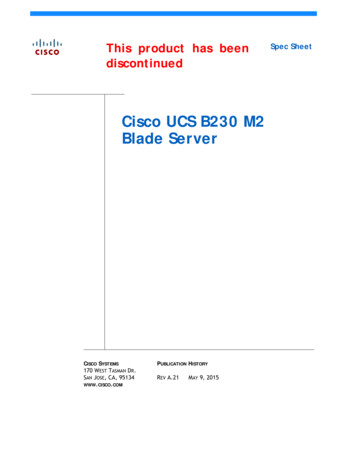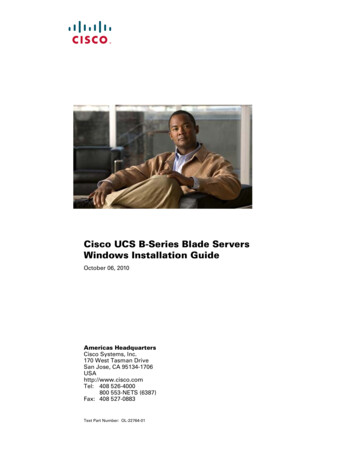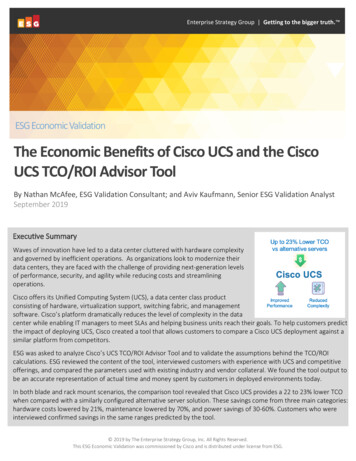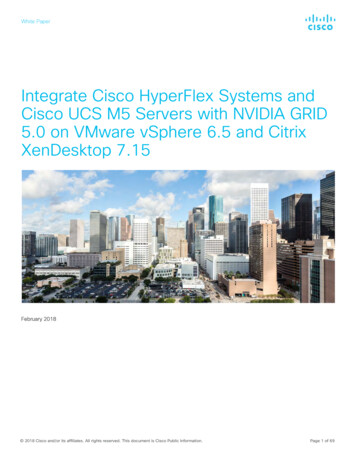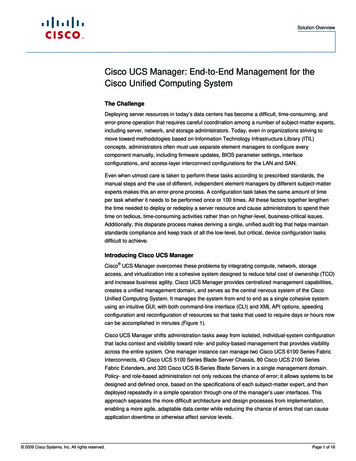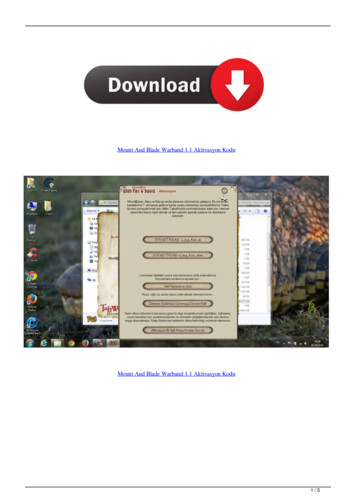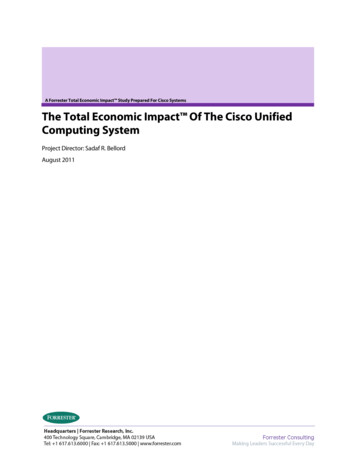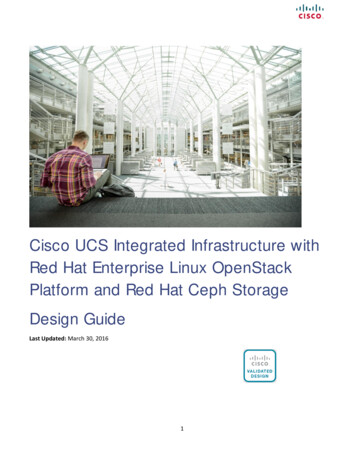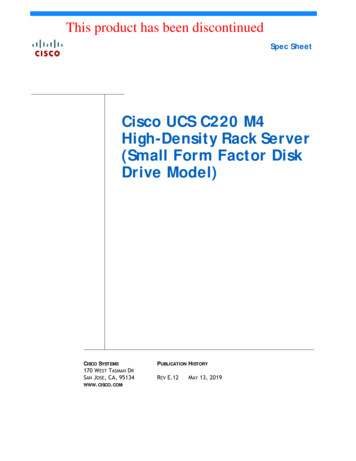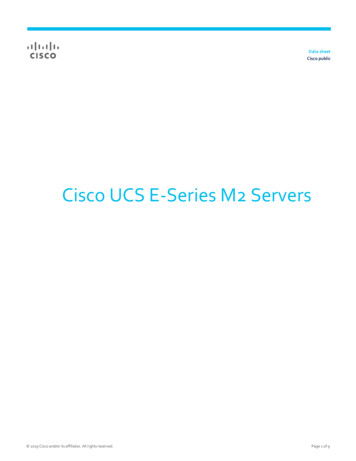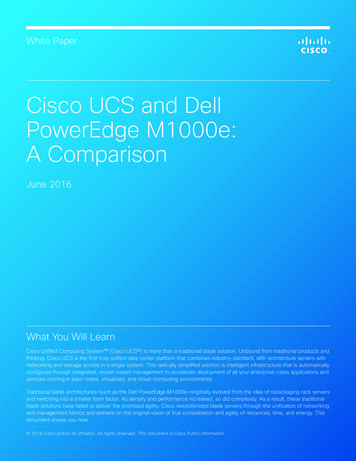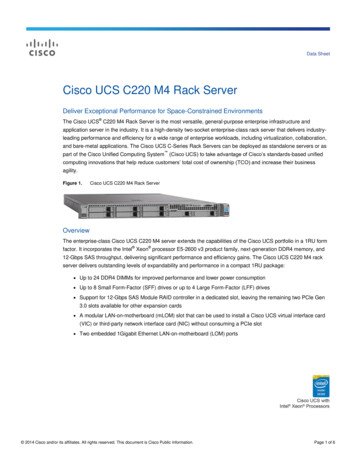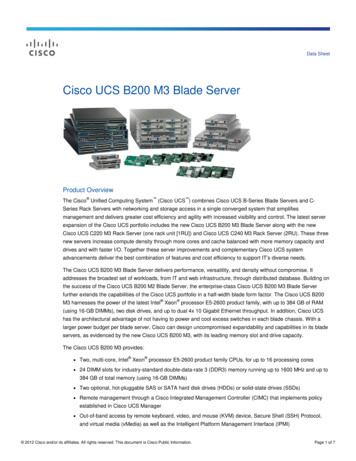
Transcription
Data SheetCisco UCS B200 M3 Blade ServerProduct Overview The Cisco Unified Computing System (Cisco UCS ) combines Cisco UCS B-Series Blade Servers and CSeries Rack Servers with networking and storage access in a single converged system that simplifiesmanagement and delivers greater cost efficiency and agility with increased visibility and control. The latest serverexpansion of the Cisco UCS portfolio includes the new Cisco UCS B200 M3 Blade Server along with the newCisco UCS C220 M3 Rack Server (one rack unit [1RU]) and Cisco UCS C240 M3 Rack Server (2RU). These threenew servers increase compute density through more cores and cache balanced with more memory capacity anddrives and with faster I/O. Together these server improvements and complementary Cisco UCS systemadvancements deliver the best combination of features and cost efficiency to support IT’s diverse needs.The Cisco UCS B200 M3 Blade Server delivers performance, versatility, and density without compromise. Itaddresses the broadest set of workloads, from IT and web infrastructure, through distributed database. Building onthe success of the Cisco UCS B200 M2 Blade Server, the enterprise-class Cisco UCS B200 M3 Blade Serverfurther extends the capabilities of the Cisco UCS portfolio in a half-width blade form factor. The Cisco UCS B200 M3 harnesses the power of the latest Intel Xeon processor E5-2600 product family, with up to 384 GB of RAM(using 16-GB DIMMs), two disk drives, and up to dual 4x 10 Gigabit Ethernet throughput. In addition, Cisco UCShas the architectural advantage of not having to power and cool excess switches in each blade chassis. With alarger power budget per blade server, Cisco can design uncompromised expandability and capabilities in its bladeservers, as evidenced by the new Cisco UCS B200 M3, with its leading memory slot and drive capacity.The Cisco UCS B200 M3 provides: Two, multi-core, Intel Xeon processor E5-2600 product family CPUs, for up to 16 processing cores 24 DIMM slots for industry-standard double-data-rate 3 (DDR3) memory running up to 1600 MHz and up to384 GB of total memory (using 16-GB DIMMs) Two optional, hot-pluggable SAS or SATA hard disk drives (HDDs) or solid-state drives (SSDs) Remote management through a Cisco Integrated Management Controller (CIMC) that implements policyestablished in Cisco UCS Manager Out-of-band access by remote keyboard, video, and mouse (KVM) device, Secure Shell (SSH) Protocol,and virtual media (vMedia) as well as the Intelligent Platform Management Interface (IPMI) 2012 Cisco and/or its affiliates. All rights reserved. This document is Cisco Public Information.Page 1 of 7
In addition, the Cisco UCS B200 M3 is a half-width blade (Figure 1). Up to eight of these high-density, two-socketblade servers can reside in the 6RU Cisco UCS 5108 Blade Server Chassis, offering one of the highest densitiesof servers per rack unit in the industry.Another Cisco innovation, the Cisco UCS Virtual Interface Card (VIC) 1240 is a 4-port 10 Gigabit Ethernet, FibreChannel over Ethernet (FCoE)-capable modular LAN on motherboard (LOM) designed exclusively for the M3generation of Cisco UCS B-Series Blade Servers. When used in combination with an optional I/O expander, theCisco UCS VIC 1240 capabilities can be expanded up to eight ports of 10 Gigabit Ethernet. The Cisco UCS VIC1240 enables a policy-based, stateless, agile server infrastructure that can present up to 256 PCI Express (PCIe)standards-compliant interfaces to the host that can be dynamically configured as either network interface cards (NICs) or host bus adapters (HBAs). In addition, the Cisco UCS VIC 1240 supports Cisco Data Center VirtualMachine Fabric Extender (VM-FEX) technology, which extends the Cisco UCS fabric interconnect ports to virtualmachines, simplifying server virtualization deployment.Figure 1.Cisco UCS B200 M3 Blade ServerThe Cisco UCS B200 M3 Blade Server continues Cisco’s commitment to delivering uniquely differentiated value,fabric integration, and ease of management that is exceptional in the marketplace. The Cisco UCS B200 M3further extends the capabilities of Cisco UCS by delivering new levels of manageability, performance, energyefficiency, reliability, security, and I/O bandwidth for enterprise-class applications:ApplicationsThe Cisco UCS B200 M3 is suited for a broad range of IT workloads: Virtualized workloads IT and web infrastructure Virtual desktops Databases Middleware Enterprise resource planning (ERP) and customer relationship management (CRM) applications 2012 Cisco and/or its affiliates. All rights reserved. This document is Cisco Public Information.Page 2 of 7
Cisco UCS Servers Change the Economics of the Data CenterIT infrastructure matters now more than ever, as organizations seek to achieve the full potential of infrastructureas a service (IaaS), bare metal, virtualized servers, and cloud computing. Cisco continues to lead in Data Centerinnovation with the introduction of new building blocks for the Cisco Unified Computing System that extend itsexceptional simplicity, agility, and efficiency (Figure 2). Innovations such as the Cisco UCS B200 M3 Blade Serverbring even better industry-leading performance from IT infrastructure to enterprise applications.Figure 2.Cisco UCS ComponentsCisco innovations, such as the Cisco UCS Manager software, allow administrators to create a software model of adesired server (using Cisco service profiles and templates) and then instantiate that server and its I/O connectivityby associating a model with physical resources. This approach contrasts with the traditional approach ofconfiguring each system resource manually, one at a time, through individual element managers. Unlike legacyvendors of traditional systems, Cisco uses a unified management model with service profiles that can be movedeasily between any Cisco UCS servers - whether blade server or rack server - in a Cisco UCS Manager domain.In other words, Cisco UCS service profiles are form-factor agnostic. 2012 Cisco and/or its affiliates. All rights reserved. This document is Cisco Public Information.Page 3 of 7
Other Cisco UCS building blocks include new Cisco UCS VIC options, expanded Cisco UCS fabric interconnects,and additional fabric extender options that expand throughput and management simplicity for both blade and rackservers across bare-metal, virtualized, and cloud environments. Cisco UCS also provides investment protection.For example, fabric extenders can be upgraded in the same Cisco UCS 5108 Server Chassis using the samefabric interconnects. Fabric interconnects can be upgraded independently of fabric extenders and blade serverswithin the chassis. The Cisco UCS 5108 Chassis high-performance midplane provides 8 blades with 1.2 terabits(Tb) of available Ethernet throughput for future blade and I/O requirements. In addition, Cisco continues toinnovate in all these areas, helping ensure that newer, more powerful blade servers have matching I/O bandwidthand computing power through continuous innovation across the Cisco UCS environment.The Cisco UCS B200 M3 is also part of a large family of blade servers: the Cisco B-Series Blade Servers.Designed to operate as part of Cisco UCS, the Cisco UCS B-Series servers employ many innovative Ciscotechnologies to help customers handle the most challenging workloads. Cisco UCS B-Series servers operating ina Cisco UCS management framework incorporate a standards-based unified network fabric, Cisco VM-FEXvirtualization support, Cisco UCS Manager software, Cisco fabric extender architecture, and Cisco ExtendedMemory Technology. Again, Cisco is innovating across all these technologies. Together, these Cisco UCSarchitectural advantages and Cisco’s software advances, Cisco’s continuous innovation, and unique blade serverand chassis designs combine to make Cisco UCS the first truly unified data center platform. In addition, CiscoUCS can transform IT organizations through policy-based automation and deep integration with familiar systemsmanagement and orchestration tools.Features and BenefitsTable 1 summarizes the features and benefits of the Cisco UCS B200 M3 server:Table 1.Features and BenefitsFeatureBenefitUnified fabric Decreases total cost of ownership (TCO) by reducing the number of NICs, HBAs, switches, and cables needed Enables the Cisco UCS 5108 chassis to eliminate in-chassis HBAs, NICs, and switches and reallocates thesaved power to denser, more powerful blade servers with more DIMM slots and better per-blade performancecompared to alternative offeringsCisco UCS Managerservice profiles Helps reduce the number of manual steps required to deploy servers in the data center, improving server policyconsistency and coherency Allows servers and support infrastructure to be provisioned in minutes instead of days, shifting IT’s focus frommaintenance to strategic initiatives Reduces configuration errors significantly as blades are added or repurposed Enables service profile movement from blade to blade, rack server to blade, blade to rack server, or blade toblade in another chassisAutodiscovery Requires no configuration; as with all Cisco UCS components, blades are automatically recognized andconfigured by Cisco UCS ManagerExtensive monitoring Through Cisco UCS Manager, provides extensive environmental monitoring for each blade Allows use of user thresholds to optimize environmental management of the bladeCisco VIC adapter Offers the Cisco UCS VIC 1240, a 4-port 10 Gigabit Ethernet, FCoE-capable adapter When used in combination with its port expander card, the Cisco UCS VIC 1240 can be expanded to eight portsof 10 Gigabit Ethernet supportMezzanine adapters Provides choice of converged network adapters (CNAs) and VIC adapters, providing flexibility, increasedperformance, compatibility with industry standards, and network policy coherence for virtualized environmentsCisco Flexible Flash(FlexFlash) memory Includes two internal Cisco FlexFlash drives (SD cards) Provides dual secure digital high-capacity (SDHC) flash card sockets on the front left side of the server forVMware ESXi loading capabilityNote: Cisco Flexibile Flash secure digital cards are currently orderable; however, they will be enabled only with futurefirmware and software updates. 2012 Cisco and/or its affiliates. All rights reserved. This document is Cisco Public Information.Page 4 of 7
FeatureBenefitOptional local storage Provides support on each blade for up to two optional front-access SAS or SATA HDDs or SSDsIntel Xeon processorE5-2600 product family Automated energy efficiency reduces energy costs by automatically putting the processor and memory in thelowest available power state while still delivering the performance required and flexible virtualization technologythat optimizes performance for virtualized environments, including processor support for migration and direct I/O Up to twice the performance for floating-point operations is provided. Intel Advanced Vector Extensions (AVX)provides new instructions that can significantly improve performance for applications that rely on floating-point orvector computations Cisco UCS B-Series servers keep pace with Intel Xeon processor innovation by offering the latest processorswith an increase in processor frequency and improved security features. With the increased performanceprovided by the Intel Xeon processor E5-2600 product family, Cisco UCS B-Series offers an improved price-toperformance ratio, making Cisco UCS servers among the best values in the industry Advanced reliability features, including Machine Check Architecture Recovery, to automatically monitor, report,and recover from hardware errors to maintain data integrity and keep mission-critical services online Hardened protection for virtual and cloud Environments: Establish trusted pools of virtual resources with Intel Trusted Execution Technology (Intel TXT). Intel TXT ensures that physical servers and hypervisors boot onlyinto cryptographically verified “known good states.” It safeguards your business more effectively by protectingyour platform from the insertion of malware during or prior to launchSpecificationsCisco UCS B-Series Blade Servers are key components of the Cisco UCS environment and are enabled by theCisco UCS Manager and Cisco UCS 6100 Series Fabric Interconnects, 5100 Series Blade Server Chassis, and2100 Series Fabric Extenders.Table 2 summarizes the specifications for the Cisco UCS B200 M3.Table 2.Product SpecificationsItemSpecificationProcessors2 Intel Xeon processor E5-2600 product family CPUsProcessor cores4, 6, or 8 cores, varying by processor modelMemory 24 DIMM slots Maximum of 384 GB with 16-GB DDR3 RDIMMsMezzanine adapter slots2 (one dedicated to Cisco UCS VIC 1240)Disk drivesUp to 2 optional front-access SAS or SATA HDDs or SSDsDisk drive options100- and 200-GB SSDs and 146-GB, 300-GB, and 600-GB SASMaximum internal storageUp to 1.2 TBDrive controller LSI SAS 2004 Integrated RAID controller RAID 0 and 1 supportFlash memory2 slots for 16-GB SD flash memory cards (future enablement via software update)ManagementManaged from the Cisco UCS 6100 or 6200 Series Fabric Interconnects by Cisco UCS ManagerTemperature: Operating50 to 95 F (10 to 35 C)Temperature:Nonoperating-40 to 149 F (-40 to 65 C)Humidity: Operating5 to 93% noncondensingHumidity: Nonoperating5 to 93% noncondensingAltitude: Operating0 to 10,000 ft (0 to 3000m); maximum ambient temperature decreases by 1 C per 300mAltitude: Nonoperating40.000 ft (12,000m) 2012 Cisco and/or its affiliates. All rights reserved. This document is Cisco Public Information.Page 5 of 7
Table 3 summarizes regulatory standards compliance.Table 3.Regulatory Standards Compliance: Safety and EMCSpecificationDescriptionRegulatory complianceProducts should comply with CE Markings according to directives 2004/108/EC and 2006/108/ECSafety UL 60950-1 No. 21CFR1040 Second Edition CAN/CSA-C22.2 No. 60950-1 Second Edition IEC 60950-1 Second Edition EN 60950-1 Second Edition IEC 60950-1 Second Edition AS/NZS 60950-1 GB4943 2001EMC: Emissions 47CFR Part 15 (CFR 47) Class A AS/NZS CISPR22 Class A CISPR2 2 Class A EN55022 Class A ICES003 Class A VCCI Class A EN61000-3-2 EN61000-3-3 KN22 Class A CNS13438 Class AEMC: Immunity EN55024 CISPR24 EN300386 KN24Warranty InformationFind warranty information at Cisco.com on the Product Warranties page.Cisco Unified Computing ServicesUsing a unified view of data center resources, Cisco and our industry-leading partners deliver services thataccelerate your transition to a unified computing environment. Cisco Unified Computing Services helps you quicklydeploy your data center resources and optimize ongoing operations to better meet your business needs. For moreinformation about these and other Cisco Data Center Services offerings, visit http://www.cisco.com/go/dcservices.Why Cisco?Cisco has significant experience in listening to customer requirements and providing solid technology innovationfor the enterprise data center. Cisco delivers standards-based solutions backed by a broad partner ecosystem ofindustry leaders to provide end-to-end customer solutions. Unified computing elevates the traditional productclassification of network, server, storage, operating systems, and applications to a data center-wide vision. Cisco,as one of the largest technology providers in the world, has the resources, expertise, and customer focus todeliver on the unified computing vision. 2012 Cisco and/or its affiliates. All rights reserved. This document is Cisco Public Information.Page 6 of 7
For More InformationFor more information about Cisco UCS B-Series Blade Servers, ndex.html or contact your local Cisco representative.For complete technical information about Cisco UCS B200 M3 Blade Servers, s10265/ps10280/B200M3 SpecSheet.pdfPrinted in USA 2012 Cisco and/or its affiliates. All rights reserved. This document is Cisco Public Information.C78-700625-0003/12Page 7 of 7
The Cisco UCS B200 M3 Blade Server delivers performance, versatility, and density without compromise. It addresses the broadest set of workloads, from IT and web infrastructure, through distributed database. Building on the success of the Cisco UCS B200 M2 Blade Server, the enterprise-class Cisco UCS B200 M3 Blade Server
